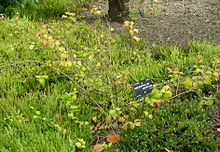| Abeliophyllum | |
|---|---|

| |
| Conservation status | |
 Endangered (IUCN 3.1) | |
| Scientific classification | |
| Kingdom: | Plantae |
| Clade: | Tracheophytes |
| Clade: | Angiosperms |
| Clade: | Eudicots |
| Clade: | Asterids |
| Order: | Lamiales |
| Family: | Oleaceae |
| Tribe: | Forsythieae |
| Genus: | Abeliophyllum Nakai |
| Species: | A. distichum |
| Binomial name | |
| Abeliophyllum distichum Nakai | |

| |
Abeliophyllum, the miseonnamu, Korean abeliophyllum, white forsythia, or Korean abelialeaf, is a monotypic genus of flowering plants in the olive family, Oleaceae. It consists of one species, Abeliophyllum distichum Nakai, endemic to Korea, where it is endangered in the wild, occurring at only seven sites. It is related to Forsythia, but differs in having white, not yellow, flowers.
Description
It is a deciduous shrub growing to 1–1.5 m (3 ft 3 in – 4 ft 11 in) tall and rounded in outline with multi-stemmed and arching branches. The leaves are opposite, simple, 5–9 cm (2–4 in) long and 3–4.5 cm (1–2 in) wide, pubescent both above and below. The flowers are produced in early spring before the new leaves appear; they are white or pink tinged, and fragrant, about 1–1.5 cm (0–1 in) in diameter, with a four-lobed corolla. The fruit is a round, winged samara 2–3 cm (1–1 in) diameter. Almost looking like an elm tree fruit.
It is cultivated as an ornamental plant in Europe and North America. Hardy to USDA Zone 4.
Taxonomy
The genus name of Abeliophyllum is in honour of Clarke Abel (1780–1826), a British surgeon and naturalist. With the latin suffix of 'phyllum' meaning leaf. The Latin specific epithet of distichum means in two ranks, referring to the leaves. It was first described and published in Bot. Mag. (Tokyo) Vol.33 on page 153 in 1919.
Conservation status
In 1998, a review of the plant's conservation status found that "it is close to extinction and qualifies for the IUCN Category of 'Critically Endangered', indicating a high risk of extinction in the near future."; but as of 2009 it has not yet been formally assessed for the IUCN Red List.
In 2015, IUCN classed the species as endangered.
References
- ^ Son, S.-W.; Kim, Y.-S.; Kim, H. (2016). "Abeliophyllum distichum". IUCN Red List of Threatened Species. 2016: e.T13188339A13189399. doi:10.2305/IUCN.UK.2016-1.RLTS.T13188339A13189399.en. Retrieved 6 September 2021.
- ^ English Names for Korean Native Plants (PDF). Pocheon: Korea National Arboretum. 2015. p. 332. ISBN 978-89-97450-98-5. Archived from the original (PDF) on 25 May 2017. Retrieved 19 December 2016 – via Korea Forest Service.
- ^ "Abeliophyllum distichum | Landscape Plants | Oregon State University". landscapeplants.oregonstate.edu. Archived from the original on 27 May 2024. Retrieved 30 January 2022.
- Burkhardt, Lotte (2022). Eine Enzyklopädie zu eponymischen Pflanzennamen [Encyclopedia of eponymic plant names] (pdf) (in German). Berlin: Botanic Garden and Botanical Museum, Freie Universität Berlin. doi:10.3372/epolist2022. ISBN 978-3-946292-41-8. S2CID 246307410. Archived from the original on August 31, 2023. Retrieved January 27, 2022.
- Harrison, Lorraine (2012). RHS Latin for Gardeners. United Kingdom: Mitchell Beazley. ISBN 978-1845337315.
- "Abeliophyllum Nakai | Plants of the World Online | Kew Science". Plants of the World Online. Archived from the original on 27 May 2024. Retrieved 30 January 2022.
- Kim, Y. S. & Maunder, M. (1998). "Plants in Peril, 24: Abeliophyllum distichum". Curtis's Botanical Magazine. 15 (2): 141–146. doi:10.1111/1467-8748.00155.
| Taxon identifiers | |
|---|---|
| Abeliophyllum | |
| Abeliophyllum distichum |
|
This Oleaceae article is a stub. You can help Misplaced Pages by expanding it. |